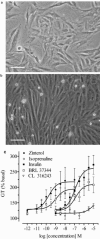Characterization of the beta-adrenoceptor subtype involved in mediation of glucose transport in L6 cells
- PMID: 12183326
- PMCID: PMC1573471
- DOI: 10.1038/sj.bjp.0704845
Characterization of the beta-adrenoceptor subtype involved in mediation of glucose transport in L6 cells
Abstract
1. The receptor that mediates the increase in glucose transport (GT) in response to beta-adrenoceptor (beta-AR) agonists was characterized in the rat skeletal muscle cell line L6, using the 2-deoxy-[(3)H]-D-glucose assay. 2. The beta(3)-AR agonist BRL37344 (pEC(50) = 6.89 +/- 0.21), the beta-AR agonist isoprenaline (pEC(50) = 8.99 +/ -0.24) and the beta(2)-AR agonist zinterol (pEC(50) = 9.74 +/- 0.15) increased GT as did insulin (pEC(50) = 6.93 +/- 0.15). The highly selective beta(3)-AR agonist CL316243 only weakly stimulated GT. 3. The pK(B) values calculated from the shift of the pEC(50) values of the agonists in the presence of the beta(1)-AR selective antagonist CGP 20712A or the beta(3)-AR selective antagonist SR 59230A were not indicative of activation of beta(1)- or beta(3)-ARs. Only (-)-propranolol and the beta(2)-AR selective antagonist ICI 118551 caused marked rightward shifts of CR curves to isoprenaline (pK(B) = 10.2 +/- 0.2 and 9.6 +/- 0.3), zinterol (pK(B) = 9.0 +/- 0.1 and 9.4 +/- 0.3) and BRL 37344 (pK(B) = 9.4 +/- 0.3 and 8.4 +/- .2), indicating participation of beta(2)-ARs. 4. The pharmacological analysis was supported by reverse transcription and polymerase chain reaction analysis of L6 mRNA, which showed high levels of expression of beta(2)-AR but not beta(1)- or beta(3)-AR in these cells. 5. Forskolin and dibutyryl cyclic AMP produced negligible increases in GT while the phosphatidylinositol-3 kinase inhibitor, wortmannin, significantly decreased both insulin- and zinterol-stimulated GT, suggesting a possible interaction between the insulin and beta(2)-AR pathways. 6. This study demonstrates that beta(2)-ARs mediate the increase in GT in L6 cells to beta-AR agonists, including the beta(3)-AR selective agonist BRL 37344. This effect does not appear to be directly related to increases in cyclic AMP but requires P13K.
Figures






References
-
- ABE H., MINOKOSHI Y., SHIMAZU T. Effect of a beta 3-adrenergic agonist, BRL35135A, on glucose uptake in rat skeletal muscle in vivo and in vitro. J. Endocrinol. 1993;139:479–486. - PubMed
-
- BIRNBAUM M.J. Identification of a novel gene encoding an insulin-responsive glucose transporter protein. Cell. 1989;57:305–315. - PubMed
-
- BOARD M., DOYLE P., CAWTHORNE M.A. BRL37344, but not CGP12177, stimulates fuel oxidation by soleus muscle in vitro. Eur. J. Pharmacol. 2000;406:33–40. - PubMed
-
- CHAMBERLAIN P.D., JENNINGS K.H., PAUL F., CORDELL J., BERRY A., HOLMES S.D., PARK J., CHAMBERS J., SENNITT M.V., STOCK M.J., CAWTHORNE M.A., YOUNG P.W., MURPHY G.J. The tissue distribution of the human β3-adrenoceptor studied using a monoclonal antibody: direct evidence of the β3-adrenoceptor in human adipose tissue, atrium and skeletal muscle. Int. J. Ob. 1999;23:1057–1065. - PubMed
-
- COHEN M.L., BLOOMQUIST W., ITO M., LOWELL B.B. Beta3 mediate relaxation in stomach fundus whereas a fourth beta receptor mediates tachycardia in atria from transgenic beta3 receptor knockout mice. Rec. Chan. 1999;7:17–23. - PubMed
Publication types
MeSH terms
Substances
LinkOut - more resources
Full Text Sources
Other Literature Sources
Research Materials
Miscellaneous

